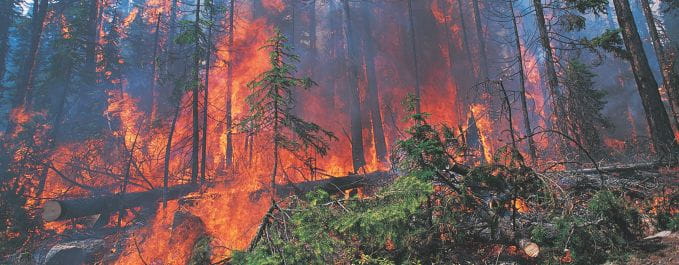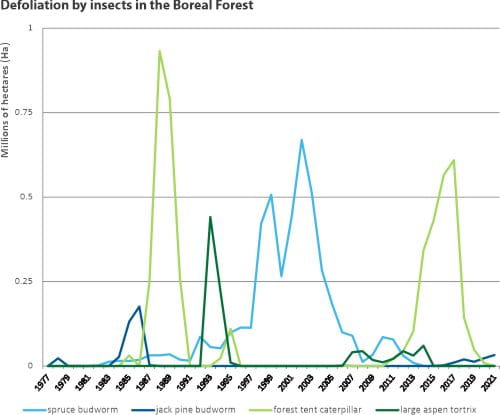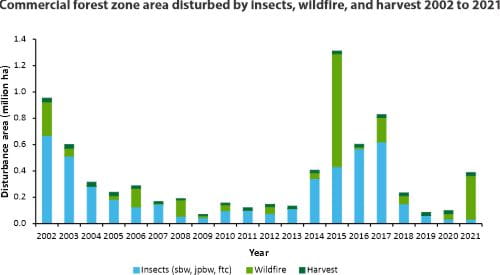
Why we measure this
Disturbances – such as wildfires – are natural and essential processes in Saskatchewan's boreal forests. They help keep the forest landscape healthy and diverse, and create a mosaic of habitat types that promotes biodiversity. Sustainable forest management is designed to emulate natural disturbances through harvesting to promote biodiversity and a mosaic of stand types and ages. Natural disturbance levels are closely tracked and monitored each year. These levels are then compared to natural disturbance thresholds established in each forest management plan, which are required to be adjusted to ensure sustainable harvest levels where disturbance exceeds the threshold.
While natural disturbances are essential to forest health and renewal, they can also have a negative impact on communities, businesses and public safety. Wildfires can threaten human safety, property and infrastructure, and smoke often becomes a public health concern. Wildfires are also a large source of greenhouse gas emissions in our province.
What is happening

Natural disturbances are nature's way of shaping the boreal forest. Tree species that grow in the boreal forest have evolved over time to adapt to, and even require, periodic disturbance as part of their natural life cycles. These disturbances can provide forest managers with a guide for how to manage timber harvest sustainably and understand how the landscape is changing from year-to-year. To do this, natural disturbances need to be understood and measured over time.<
Insect and disease disturbances are a natural part of the forest ecosystem, but can become problematic when large outbreaks occur. Insects – such as jack pine budworm, forest tent caterpillar and large aspen tortrix – feed on tree foliage and can cause tree mortality after repeated attacks. All of these insects are cyclic in their outbreak behaviours. The spruce budworm cycle is relatively long, with peak outbreaks affecting spruce and fir foliage expected to occur roughly 35 years apart. The most recent outbreak peaked in 2002. Forest tent caterpillar outbreaks in hardwood foliage typically occur every 10-12 years, with outbreaks lasting three to five years. The pattern of outbreaks has been quite regular – occurring in 1986 to 1991, 2001 to 2007 and 2013 to 2019.

Aerial mapping data was unavailable for the early 2000s forest tent caterpillar outbreak and therefore the information does not appear on the graph.
Physical disturbances, such as drought, flooding and extreme wind events, contribute to a biologically diverse and healthy forest as well, but can often result in tree mortality and changes to the forest ecosystem. These types of disturbances can be harder to track and manage.
Wildfire is the largest driver of change in the boreal forest. In pre-industrial times, the boreal plain eco- zone (which is where most of the commercial forest is today) had a fire return interval that averaged 70 years. This means that the likelihood of a fire occurring within a forest type was around once every 70 years. However, the type of fire disturbance would depend on a variety of factors such as weather, moisture levels, stand age, composition and structure. Almost all stands of mature forest you see today in the boreal forest are the result of past wildfires. Wildfires occur less frequently today due to fire prevention and suppression where cabins, infrastructure and other items of value are at risk, but they are still the largest disturbance in the forest. The area burned varies from year to year and is significantly affected by weather. While the number and size of catastrophic wildfires in some North American jurisdictions has increased over the last five years, 20 years of available data do not show any statistically significant increasing trend in Saskatchewan. A changing climate may extend the wildfire season, and the potential for more extreme weather events may be conducive to more wildfires that have a higher burn severity and intensity.


Harvest area for the years 2020 and 2021 was estimated based on the area reported for 2019.
What we are doing
The Government of Saskatchewan closely monitors and tracks wildfire activity, harvest levels, tree diseases and insect outbreaks to ensure forest resources are being managed sustainably. Monitoring is a key component of sustainable forest management.
To assess the health of Saskatchewan's forests, the ministry conducts annual aerial surveys to monitor insects, diseases and weather events that cause major forest disturbances. All harvesting in Saskatchewan is closely measured using a variety of tools, and harvest areas are mapped using satellite imagery. Forest managers use this information to guide their planning and decision making. Forest management plans are assessed annually to ensure forest conditions are healthy and harvest levels are sustainable. When natural disturbance levels exceed the re-planning threshold, long-term harvesting plans must be re-modelled. Forest managers are also using the science and principles of natural forest patterns to design harvesting that more closely resembles the shapes and sizes of wildfires.
Saskatchewan uses modern technology and decision-making systems to detect, monitor and suppress wildfires. Resources are also dedicated towards preventing and mitigating wildfires near communities through FireSmart activities.
